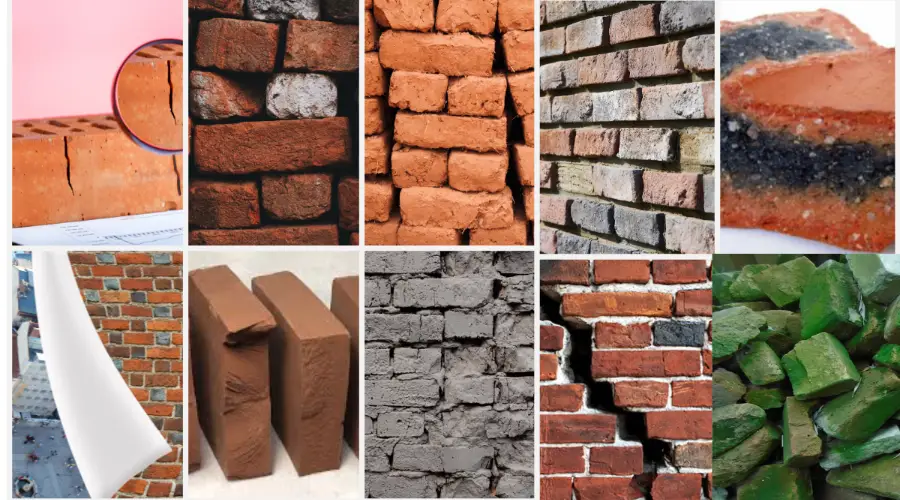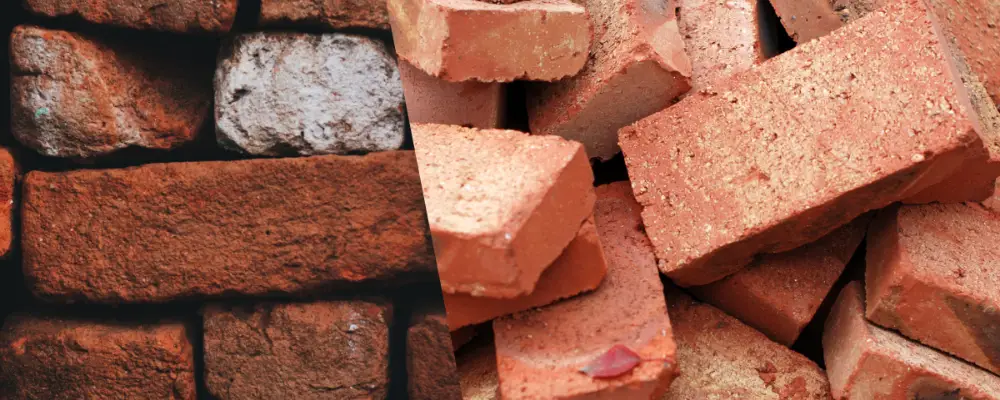A brick is one of the most commonly used construction materials and has been used for thousands of years. It is the oldest building material that provides strength, durability, reliability, and aesthetic beauty to the construction. Over the years, bricks have evolved, and now there are a variety of bricks in the market, depending on their raw materials, properties, and applications. It is crucial to choose good-quality bricks, as poor-quality bricks could completely sabotage your dream project. So, how do we identify defects in bricks? Here are the different types of defects in bricks.
Different Types of Defects in Bricks

Poor Quality Bricks are vulnerable to numerous defects, and some of the most common defects in bricks include:
- Underburning
- Spots
- Spalling
- Overburning
- Lime Blowing
- Lamination
- Efflorescence
- Chuffs
- Checks or Cracks
- Bloating
- Blisters
- Black Core
Underburning
When bricks are not burnt to complete vitrification, the clay softens, and pores remain open due to insufficient heat. This results in low compressive strength and high water absorption, making them unsuitable for construction work.
Spots
It is a dark spot on the bricks’ surface caused by iron sulfide in the clay. The spots affect the structural integrity and visual appeal, making it unsuitable for exposed masonry work.
Spalling
Spalling refers to flaking, cracking, peeling, crumpling, or chipping of bricks, resulting in the irregular portions of the bricks breaking or falling off. This is caused by the heating of water inside the bricks.
Overburning
This is caused by over-burning due to excess temperature inside the kiln or burning faces. The overburnt bricks result in a soft molten mass. The bricks lose their shape and become unsuitable for construction.
Lime Blowing
The disintegration of bricks causes lime blowing in bricks. If bricks contain a lime lump, the lime absorbs water and expands after firing, resulting in lime blowing. It can be identified by immersing a brick in water. If the soaked brick develops fractures or powdery lumps, the brick has a blowing defect.
Lamination
It is a defect where a thin lamina is produced on the surface of the brick, which flakes out due to atmospheric conditions. The lamination of the brick is due to the air voids in the clay, resulting in weak bricks. This reduces the load-bearing capacity and durability of the bricks in masonry work.
Efflorescence
Efflorescence is the formation of a crystalline, salty deposit on the surface of the brick due to the excess alkali present in the brick. It occurs when the bricks are exposed to moisture, where the brick absorbs water and alkali crystallises. It can be identified by soaking a brick in the water. If the soaked brick forms a drying grey or white powder patch after 24 hours, it indicates efflorescence in bricks. The efflorescence can be prevented by selecting proper clay materials and providing necessary water-repellant materials in mortar and damp-proof courses.
Chuffs
It is the deformation in the shape of bricks due to the exposure of hot bricks to rainwater. The irregular shape of the bricks could affect the alignment and interlocking of bricks, weakening the structural integrity of the structure.
Checks or Cracks
The bricks are subjected to two types of cracks: straight and random cracks. Straight cracks occur parallel to the short surface of the brick due to rapid drying. In contrast, random cracks occur on different brick surfaces due to lumps of lime and excess water. This happens when an excess of water is added to the bricks during manufacturing, leading to shrinkage and burning cracks.
Bloating
Bloating is the spongy, swollen mass forming on the surface of burnt bricks. It occurs due to excess carbonaceous matter and sulfur in the bricks.
Blisters
Blisters in bricks occur on the surface of sewer pipes and drain tiles. This is due to poor compaction during the molding process. The air voids imprisoned in the brick are the main reason for the blistering of bricks.
Black Core
It is the presence of circular or semi-circular shaped black or grey spots around the core of the fire clay bricks. It is caused by the bitumen or carbon content in the earthy clay and improper burning of bricks. These bricks have reduced strength, low structural integrity, and reduced load-bearing capacity.
Why is Proper Storage of Bricks Important?
Bricks are made of clay and natural materials and are prone to moisture, temperature changes, and exposure to sunlight. To maintain their quality and durability, proper brick storage is crucial. It prevents the bricks from potential damage or deterioration caused by external factors and keeps the bricks with their original physical properties.
How to Store Bricks Properly?
- Create a foundation of loose gravel outside to keep the bricks dry. The selected space should be free from exposure to rain or sun.
- Dig a shallow hole and cover it with plastic for an outdoor solution with all the benefits of being under a roof.
- Stack the bricks in a way that they cannot fall and cause damage.
- Clay and cement bricks should be stacked and stored separately to retain their durability and longevity.
- Solid, perforated, and hollow bricks should be stacked separately to avoid fluctuation and loss of density.
- It is important to note that the stacking of bricks should not exceed 10 bricks in height.
Conclusion
Bricks are strong and reliable construction materials that provide numerous benefits in terms of strength, durability, and aesthetic beauty to the building. Compromising the strength or looks by choosing poor quality, defective bricks could result in major damages and even complete demolition. You should always test bricks for all the above defects and choose good-quality bricks for your dream project to prevent costly mistakes.

